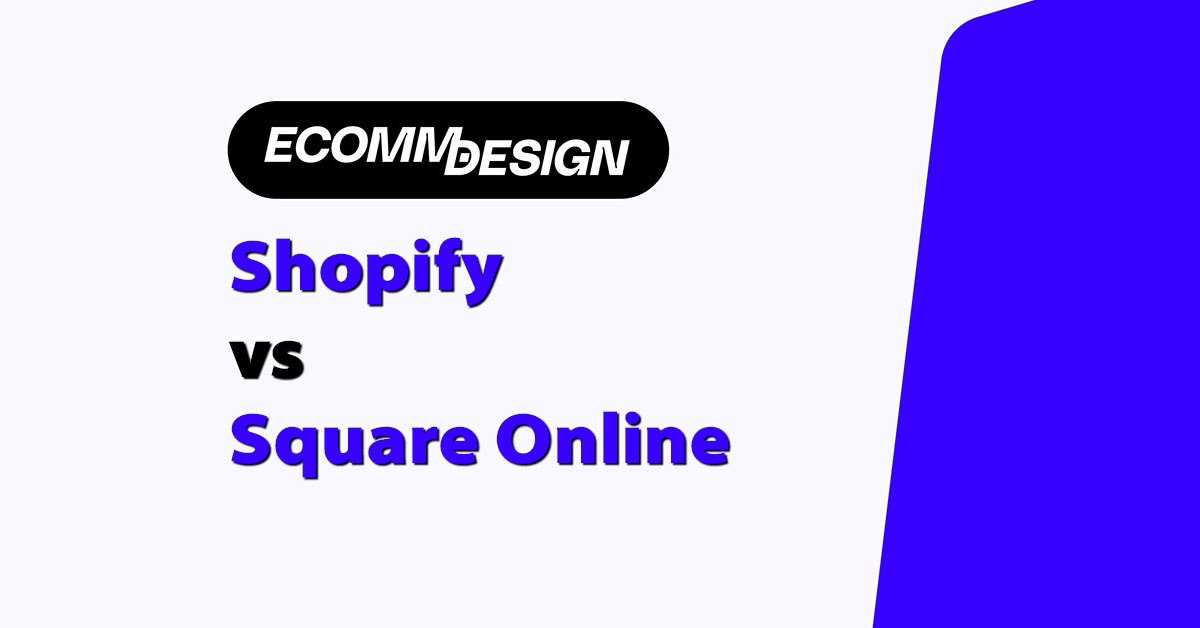
Looking for the best platform for your online store? Both Shopify and Square Online have a lot of advantages to offer.
Overall, Shopify is the better all-around ecommerce platform, with more powerful sales features and scalable solutions.
But Square Online could be an appealing choice too – particularly if you’re looking for a way to start selling online easily, with no setup fees.
Plus, let’s not forget that you also get a fantastic point of sale system with Square (although Shopify POS is pretty impressive too).
Still not sure which option to pick?
Here’s what you need to know.
Shopify vs Square Online: My Quick Verdict
If you’re looking for the best ecommerce platform overall, Shopify is the easy pick.
It has better website design tools, more marketing features, stronger omnichannel selling capabilities, and thousands of integrations available. It’s particularly great for scaling online stores.
Square is a good choice if you’re looking for a simple way to start an online store for free – but it won’t give you all of the capabilities you need to really grow as a larger business.
Still, its POS features are difficult to beat.
Shopify Pros and Cons
Pros
- Fantastic website builder with lots of flexible themes
- More advanced sales features (particularly for omnichannel selling)
- Powerful AI capabilities
- Strong business and order management toolsExcellent range of apps, integrations, and payment processors
Cons
- Slightly expensive pricing
- Extra fees for third-party payment processors
- Limited free themes
Square Online Pros and Cons
Pros
- Free website builder for beginners
- One of the best point of sale systems on the market
- Easy-to-use ecosystem with beginner-friendly tools
- Responsive help and support team
- Easy reporting and tracking tools
Cons
- Not very scalable for larger stores
- Limited payment options
- Fewer tools for web design and advanced ecommerce
Shopify vs Square Online: Pricing Plans
I’d always recommend looking beyond “pricing” when you’re comparing ecommerce tools – but let’s face it, we all have budgets we need to stick to.
Ultimately, Square is definitely the more affordable option here. It’s actually one of the few ecommerce solutions you can start using for free.
The free plan gives you access to Square’s site builder and basic design tools.
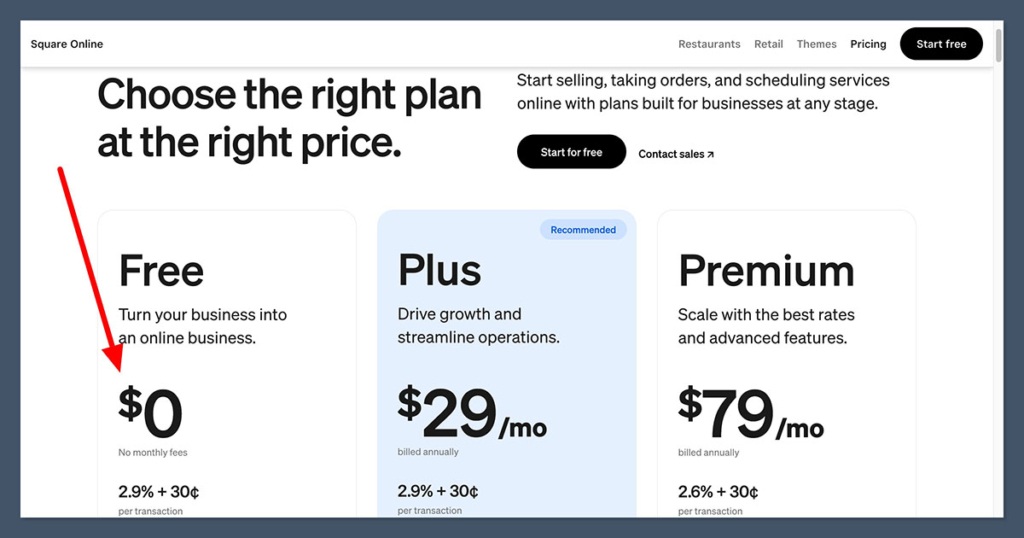
You can even sell through Facebook and Instagram, connect your Google Business profile, accept various payment methods, and sync your store with Square POS.
Beyond the free plan, you can explore:
- Square Online Plus: $29 per month: All the features of the free plan, plus a free domain for your first year, customer accounts, and professional site themes.
- Square Online Premium: $79 per month: The features of the Plus plan, as well as real-time shipping rates, advanced customer support, and QR code ordering.
Shopify has no free plan, and its free trial is limited to just three days (although you can currently get Shopify for $1 per month for the first three months).
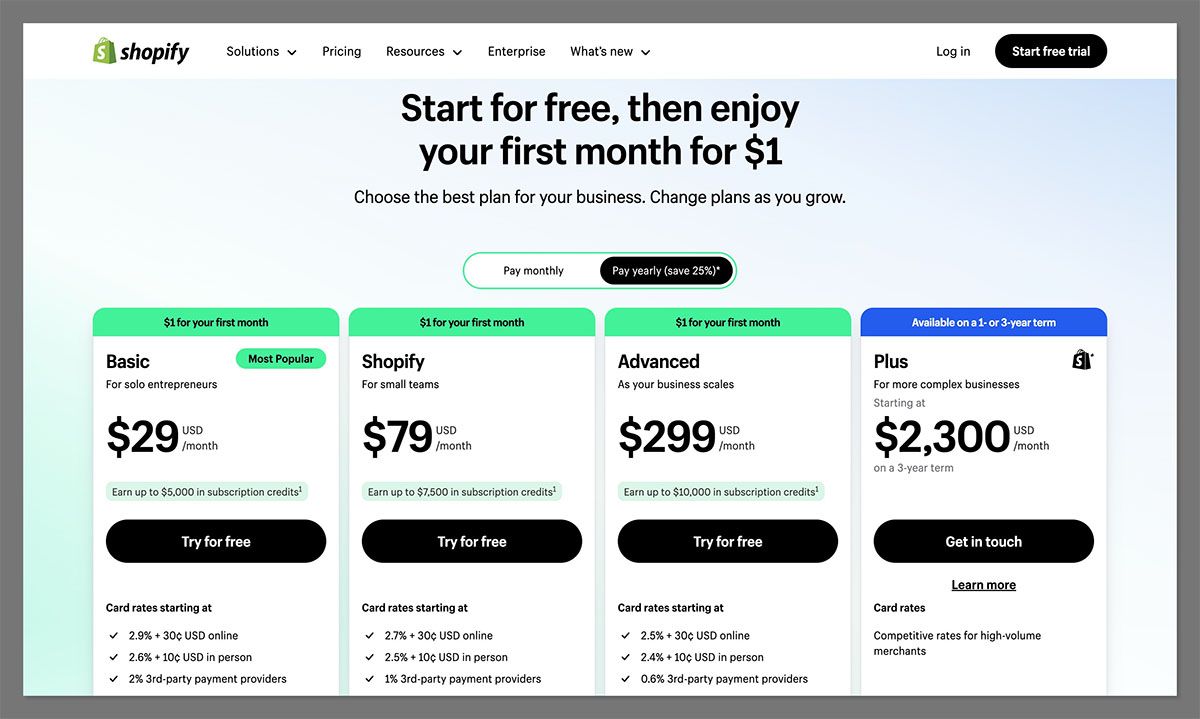
The core paid plans include:
- Shopify Basic: $29 per month: The full store builder, 10 inventory locations, 24/7 chat support, shipping discounts, unlimited products, and omnichannel selling.
- Shopify: $79 per month: All the features of the Basic plan, plus higher shipping discounts, five staff accounts, and a few extras.
- Shopify Advanced: $299 per month: Al the Shopify plan features, plus 15 staff accounts, increased checkout capacity (10x), and enhanced support.
There’s also Shopify Plus (for enterprise companies), and Shopify Starter (for social sellers).
Keep in mind, if you use a third-party payment processor with Shopify, you’ll have transaction fees to pay.
Shopify vs Square Online: The Core Features
On the surface, a lot of ecommerce tools can feel pretty similar at first – but when you really start drilling down into options like Shopify and Square Online, it becomes increasingly clear that they’re targeting very different customers.
Website Design Features
With Square Online, you’re really only getting the basic tools you need to start selling online.
This solution isn’t really meant for building and managing a revolutionary brand. Sure, the templates you get are professional-looking, and relatively versatile, but there aren’t a lot of choices.
In fact, you only get 3 free options, and 24 paid alternatives.
If you want to access the paid themes, you also need to upgrade to a paid plan (you can’t use the free plan with premium themes).
You also can’t really customize a lot. You’ll be able to create a few things, like scrolling banners and mega menus, but making your store look unique is tough.
Shopify gives you about 13 free themes to choose from, and over 200 professional themes (with one-off prices).
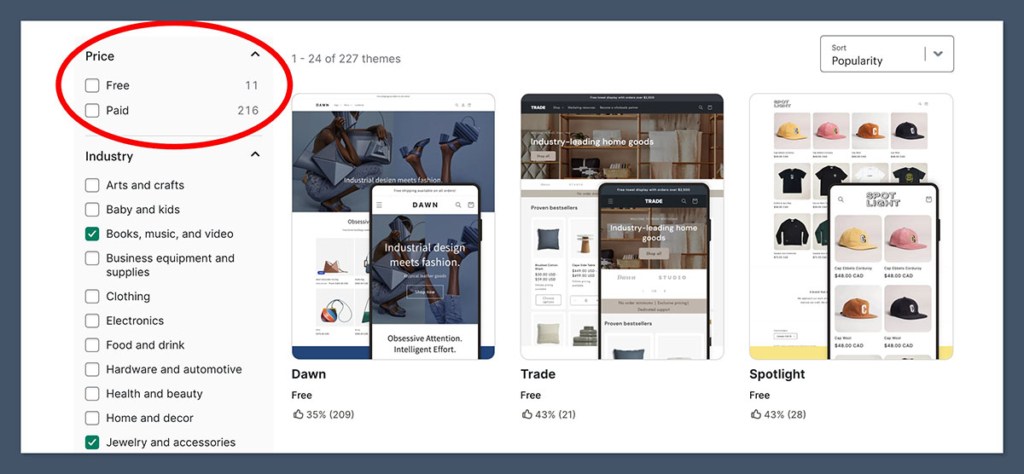
You can also work with designers to build custom themes from scratch.
The themes here are a lot more versatile. Some even come with unique built-in features like lookbooks and slide-out carts.
The design tools are a lot more intuitive too.
With Square, I had to go through a generic set-up process where I answered questions about my company and tweaked a couple of settings.
With Shopify, I could use the theme editor to really dive into granular settings and make fine-tuned adjustments.
Ecommerce and Sales Capabilities
For me, Shopify is hands-down the stronger platform from an ecommerce perspective.

It’s my top-rated platform, packed with countless advanced tools that other companies simply don’t match.
For instance, when it comes to omnichannel selling, Shopify makes it easy to connect your store with social media channels, online marketplaces, and even an integrated POS system.
Square also (obviously) supports POS integrations, but there aren’t a lot of options for selling on marketplaces or social media channels outside of Facebook or Instagram.
Then, when it comes to shopping options, both companies allow you to set your own shipping rules, with free shipping, flat shipping, and weight-based settings.
However, Shopify does have an integrated “Shipping” feature, with real-time shipping rates, labels, and discounts.
Additionally, from a payment options perspective, Shopify gives you more than 100 payment options to choose from, as well as a dedicated payment processor, with competitive rates.
I’d definitely recommend considering Shopify Payments for your store – since it allows you to bypass the extra transaction fees you’d need to pay with a third-party provider.
Square doesn’t have quite as many payment options available, but it does offer some BNPL solutions and options for Google and Apple Pay.
Beyond all that, Shopify makes it easy to sell internationally with its Markets tools, and it has brilliant features for inventory, order, and customer management.
Marketing and SEO
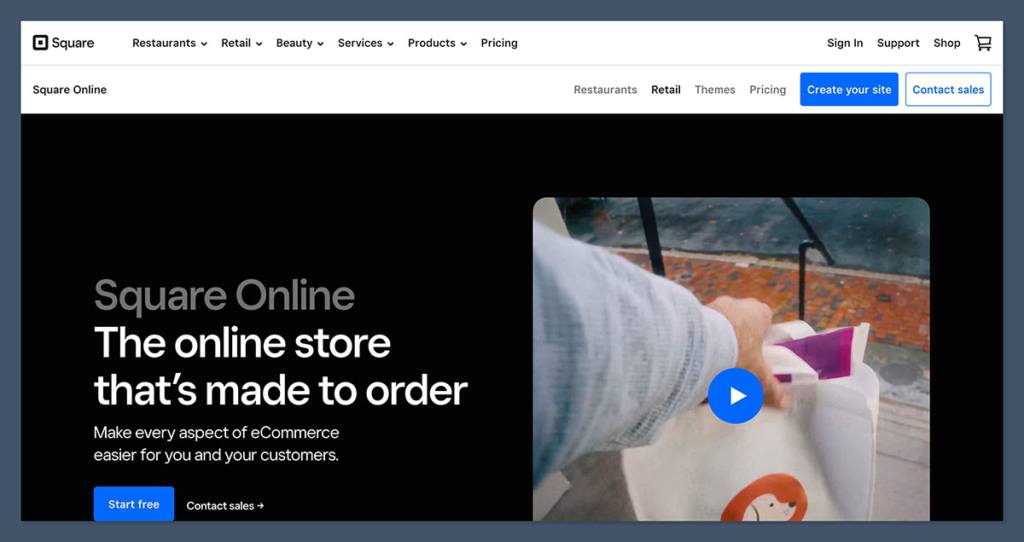
Shopify and Square Online are pretty evenly matched in some marketing areas.
For instance, they both give you control over the basic “SEO elements” of your site, like allowing you to create custom URLs, meta descriptions, title tags, and alt descriptions for images.
However, Shopify does offer some slightly more advanced SEO features too.
For instance, it can automatically generate certain tags, and Shopify Magic can help you customize content with specific keywords.
Plus, Shopify has an edge from a blogging perspective.
Both tools do allow you to create your own blog for content marketing, but Shopify gives you more tools for customizing posts, and even allows customers to comment on them.
Square makes it a little more difficult to create blog posts, and you can’t add a lot of images to content or other features.
Both platforms do have AI content creation tools (only on the paid plans for Square), but I think Shopify’s are a little stronger.
Notably, I think Shopify and Square are pretty similar from an email marketing perspective – as both do allow you to create emails without an external tool.
However, I always recommend using a third-party email marketing platform, when possible, for access to more advanced segmentation and automation features – and Shopify gives you more options here.
Notably, Shopify also has other handy marketing apps and features, like Shopify Inbox for conversational marketing, and tons of social media integration features.
Integrations and Scalability
I’ve already mentioned that I think Shopify is the more scalable platform here – appealing to companies large and small, whereas Square Online is mostly for small businesses.
For instance, consider the fact that Shopify gives you access to tools like Markets for localized global selling, as well as automation systems like Shopify Flow. You don’t get those with Square.
Shopify also has a much larger app marketplace than Square.
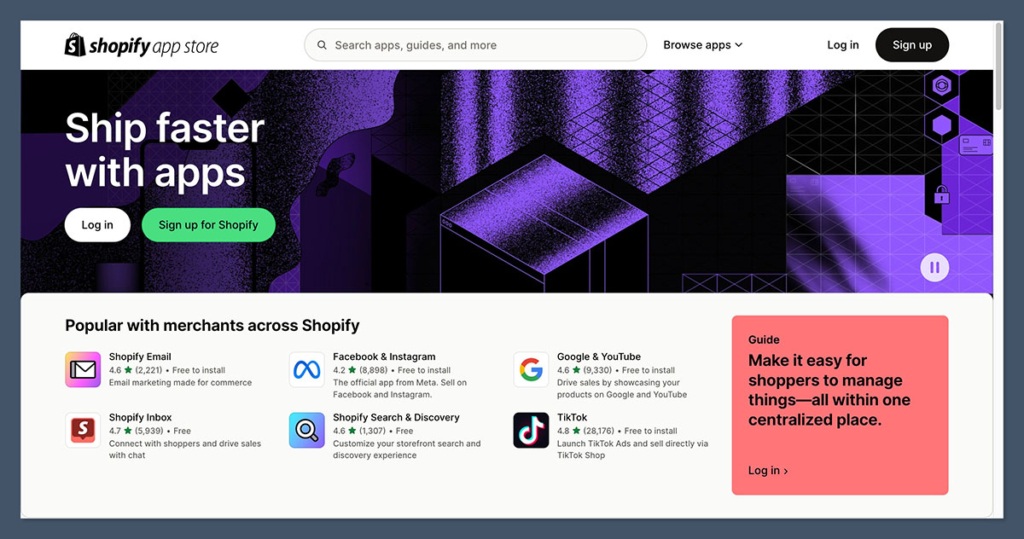
Although Square does integrate with a handful of tools, most connectors are for its POS system – not its store builder.
Shopify’s app market is on the other hand, hosts thousands of apps covering everything from invoicing and accounting to marketing, sales, customer service, and beyond.
Whatever you can imagine to make your ecommerce website stronger, Shopify probably has an app for it.
Shopify vs Square Online: Ease of Use and Customer Support
Last, we come to ease of use and customer support.
Overall, I’d probably say it’s a little faster to setup a store with Square Online – as it walks you through the entire process from start to finish.
Plus, you don’t have as many features that you can tweak with Square Online, so you’re likely to spend a lot less time on the configuration process.
However, both platforms are relatively easy to use, and I do think Shopify is a lot more intuitive when it comes to certain things, like accessing integrations, or adjusting themes.
Even writing blog posts is easier on Shopify – in my opinion.
For customer service, the two platforms are pretty much neck-and-neck in terms of self-service resources.
Both offer great AI tools (although Shopify Sidekick is a lot stronger when you’re setting up your store). They also both give customers a lot of tutorials and guides.
However, Shopify has a stronger range of video tutorials, business courses, and blogs.
If you want direct assistance though, Square is probably the winner, because it allows customers to contact the support team via email, live chat, phone call (during business hours), or a community.
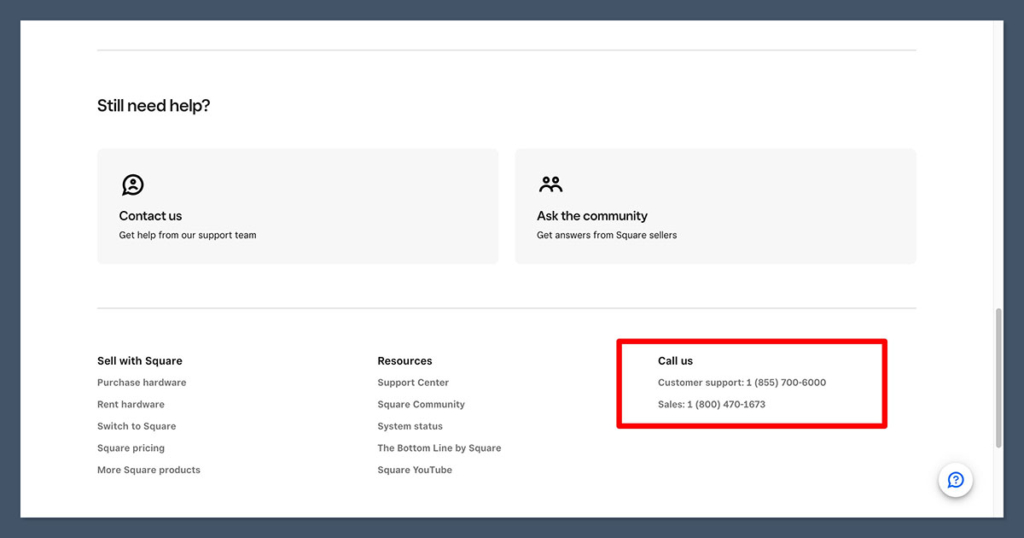
Shopify has its own community, but it only offers live chat and email support to most users. Though it is worth noting that Shopify does offer support 24/7.
Shopify vs Square Online: The Final Verdict
Ultimately, both Shopify and Square Online are great ecommerce tools.
But, overall, Shopify is the better pick.
Square is great for beginners who want a cost-effective way to start selling online, but a lack of advanced features and scalability means you’ll probably need to switch providers pretty fast.
Shopify gives you a platform that’s more likely to scale with you as your business grows – no matter what your requirements might be.
Although it’s a little more expensive, it’s definitely well-worth the investment for a serious online seller.



